 Image search results - "Toyama" Image search results - "Toyama" |

Ainokura can be reached by bus from Shirakawa-go in Gifu Prefecture. Some scenery along the way by bus to Ainokura.
|
|

Toyama Castle 富山城
|
|
|
|

Looks like Suganuma, another village in Gokayama area.
|
|

Reconstructed in 1954, modeled after Hikone and Inuyama Castles. Renovated in Nov. 2005.
|
|
|
|

Entry road to Ainokura village. Bus stop shelter on right.
|
|

Toyama Castle
|
|

Way to Ainokura, one of the gasshou-zukuri villages in the Gokayama region designated as a World Heritage Site. Ainokura has over 20 houses with steep thatched-roof houses amid high mountains. Ainokura is also a National Important Traditional Townscape Preservation District (重要伝統的建造物群保存地区).
|
|
|

What you see first is a big parking lot for tour buses. Then you see the hordes of tourists.
|
|
|

Ainokura monument
|
|
|

View of Ainokura which is also a National Important Traditional Townscape Preservation District (重要伝統的建造物群保存地区).
|
|
|

One of Japan's three Big Buddhas (after Nara and Kamakura). The statue was built by local coppersmiths in 1932, taking 30 years to complete.
|
|

JR Takaoka Station (north side) 高岡駅
|
|

View of Ainokura from a hill
|
|
|

The Takaoka Daibutsu stands 15.85 meters high, weighing 65 tons. Japan's largest copper statue. Takaoka, Toyama
|
|

Inside Takaoka Station passage
|
|
|
|
|

In front of JR Takaoka Station (north side)
|
|

In fall 2007, it underwent major renovation.
|
|
|
|

Bird's eye view of Ainokura 相倉展望台
|
|

Sculpture in front of Takaoka Station (north side)
|
|
|
|
|
|

Sculpture in front of Takaoka Station (north side)
|
|

Ainokura
|
|
|
|

JR Takaoka Station (south side)
|
|
|

Castle tower (local history museum) admission is 210 yen. 富山市郷土博物館
|
|

Shopping street near Takaoka Station
|
|

Inside Toyama Castle tower
|
|
|

Sculpture along a shopping street
|
|

Ainokura
|
|
|

Ainokura is smaller than Shirakawa-go, but still tourist-driven.
|
|
|
|
|
|
|
|
|
|
|
|
|

Center of Ainokura and souvenir shop.
|
|

Top floor of castle tower
|
|

Thatched roofs
|
|

Balcony of Toyama Castle tower
|
|
|
|

Ainenji temple 相念寺
|
|

View from Toyama Castle tower
|
|

These pictures were taken in the fall.
|
|
|
|
|
|

Spare thatch, Ainokura
|
|
|
|

Center of Ainokura
|
|

Balcony of Toyama Castle tower
|
|
|
|
|

Toyama Castle tower
|
|

Monument in the center of Ainokura.
|
|
|
|
|
|

Gassho Storehouse 合掌小屋造り
|
|
|
|
|
|

Restrooms
|
|
|

Looks traditional on the outside, but modern on the inside.
|
|
|

Thatched roof and persimmon tree
|
|
|
|
|
|
|
|

Fire hydrant
|
|
|

Ainokura Folk Museum No. 1 南砺市相倉民俗館1号館Exhibits related to life in Ainokura and the gassho-zukuri houses.
|
|
|

Ainokura Folk Museum No. 1
|
|
|
|
|

Inside Ainokura Folk Museum No. 1
|
|
|

Toyama Castle
|
|

Inside Ainokura Folk Museum No. 1
|
|

Inside Ainokura Folk Museum No. 1
|
|
|

Roof peg
|
|
|

Gassho hari
|
|

Silk-making implements
|
|
|

Hair pins
|
|

Snow coat made of straw.
|
|

Snow outfit
|
|
|
|
|
|

Spare thatch
|
|
|

Left side was recently reroofed.
|
|

Ainokura Folk Museum No. 2 南砺市相倉民俗館2号館Exhibits related to the traditional industries of Ainokura such as gunpowder manufacturing and washi paper making.
|
|

Inside Ainokura Folk Museum No. 2
|
|

Implements for making gunpowder used in matchlock guns.
|
|

Traditional musical instruments.
|
|
|
|

Kimono
|
|
|

Washi paper
|
|
|
|

Shrine
|
|

Shrine torii
|
|

Shrine
|
|
|
|

Monument commemorating the marriage of Crown Prince Hiro (right) and birth of Princess Aiko (left)
|
|
|
|

Souvenir of Ainokura
|
|

Road sign showing way to Ainokura.
|
|

Johana Station
|
|

Entrance to Ariake Colosseum for the game between Tokyo Apache and Toyama Grouses on Dec. 27, 2008.
|
|

Sign for Tokyo Apache vs. Toyama Grouses on Dec. 27, 2008.
|
|

Division standings as of Dec. 21, 2008. Tokyo Apache in 1st place, and Grouses in last place among the six teams in the Eastern conference of the bj-league.
|
|

Tip off
|
|

John "Helicopter" Humphrey
|
|
|
|
|

Masashi Joho
|
|
|
|
|

Tokyo Apache Dance Team do their stuff during time outs. They are the cheerleaders who appear on Saturday games.
|
|
|
|
|
|
|

Half-time show by Tokyo Apache Dance Team.
|
|

Darin Maki
|
|
|
|
|

A foul by Babacar Camara led to a brief scuffle between him and John Humphrey. After some deliberation by the referees, both were expelled from the game.
|
|

Jun Iwasa
|
|
|
|
|
|
|

Cohey Aoki
|
|

Cohey
|
|
|
|
|
|
|

Progression of a dunk shot.
|
|
|

Tip off
|
|
|
|
|
|
|
|
|
|
|
|

Going up against Babacar Camara.
|
|

Gum Q
|
|
|
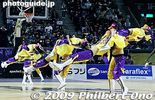
Wow, GumQ were great performers.
|
|

Some footwork by Masashi Joho.
|
|
|

Nick Davis
|
|

Sponsors
|
|
|
|
|
|
|
|
|

Skills Challenge was held during halftime. Several contestants try to dribble through a course for shooting and passing a basketball.
|
|

Tokyo Apache team bench.
|
|
|
|

Full of pep and vitality. Great for basketball games.
|
|
|
|
|
|
|
|
|
|

Dunk shot progression.
|
|
|

Babacar Camara again as John's nemesis.
|
|

Coach Bryant advises John.
|
|
|
|

Cohey for a free throw.
|
|

Team huddle
|
|

Joho for a free throw.
|
|

A sweet victory by the Tokyo Apache following a defeat the day before.
|
|
|
|
|

Joe Bryant
|
|
|
|
|
|
|

Toyama Grouses head coach Takatoshi Ishibashi, a former player for the Grouses.
|
|

Tokyo Apache head coach Joe Bryant (Kobe's dad) is upbeat after his win as he talks to the press through an interpreter.
|
|

Toyama Prefecture's main port is actually three separate ports collectively named Fushiki Toyama Port (伏木富山港). The three ports are Fushiki Port (伏木港) in Takaoka, Toyama Port (富山港) in Toyama city, and Toyama Shinko Port.
|
|
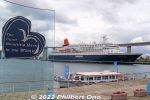
Cruise ships usually dock here at Toyama Shinko Port (富山新港). In Oct. 2014, Toyama Bay was admitted to the "Most Beautiful Bays In The World Club." This is one monument for it. https://world-bays.com/category/bays/asia/japan/
|
|
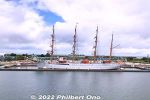
Toyama Shinko Port (also called Toyama New Port) has a major tourist attraction in the Kaiwo Maru (海王丸) museum ship brought here in July 1992.
|
|

Kaiwo Maru was built in 1930 as an officer training ship for Japan's merchant marine. Its sister ship was the original Nippon Maru sailing ship also built in 1930 as a training ship. Kaiwo Maru was retired in 1989 and replaced by a new Kaio Mar
|
|

The Kaiwo Maru was launched on Feb. 14, 1930, Valentine's Day, so people have associated the ship with love. Yumi Katsura Lover's Sanctuary Monument and Kaiwo Maru in the background.
|
|

Yumi Katsura Lover's Sanctuary Monument built in 2006. Yumi Katsura is a wedding dress designer.
|
|
|

Monument for awards bestowed on Kaiwo Maru Park for waterfront park design and concept.
|
|

Kaiwo Maru Park sign of love especially for Valentine's Day.
|
|

Kaiwo Maru and a Japanese cruise ship at Toyama Shinko Port.
|
|

About 10 times a year, they unfurl Kaio Maru's sails. Lucky if you see it with all the sails out.
|
|

For a small admission fee, you can board and tour inside Kaiwo Maru. Well worth it.
|
|

Bow of Kaiwo Maru.
|
|

Stern of Kaiwo Maru.
|
|

Gangway to board Kaiwo Maru.
|
|

About Kaiwo Maru. It's 97 meters long. "Kaiwo" (or Kaio) means "King of the Seas."
|
|

Brief history of Kaiwo Maru.
|
|

Boarding the Kaiwo Maru museum ship.
|
|

Visitors can tour the top deck (forecastle and poop decks), upper deck, and 2nd deck. Upper deck has the dining/lecture room, Captain's quarters, and officer's saloon. The 2nd deck has cadet cabins.
|
|
|
|
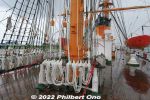
Walking on the top deck.
|
|
|

The stairs go to the bridge.
|
|
|
|

Inside the bridge of the Kaiwo Maru.
|
|
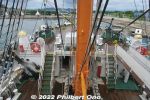
Forward view from the bridge of the Kaiwo Maru.
|
|
|
|
|